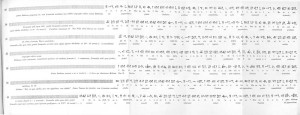The rather bland title of The Persian Cuneiform Inscription at Behistun, Deciphered and Translateddoesn’t quite capture the Indiana Jones tactics that Major Rawlinson went to in the mid 1800s in order to write his book about the inscription. The Behistun Inscription was chiseled into a cliff in what is now Iran, under the direction of Darius the Great between 522 BC and 486 BC. It is essentially a relief and description of how awesome he was as ruler of the Persians.
 Since the cliff is, well, a cliff, getting close enough to read it was not easy. First Rawlinson scaled the cliff to get to the narrow ledge below the Old Persian section. But the Elamite inscription was across as a chasm, and the Babylonian was four meters above. He made it across the chasm by doing a balancing act on wooden planks spanning the divide. He paid a local boy to climb a crack in the rock to put ropes across the Babylonian inscription so he could make papier-mâché casts of the writing.
Since the cliff is, well, a cliff, getting close enough to read it was not easy. First Rawlinson scaled the cliff to get to the narrow ledge below the Old Persian section. But the Elamite inscription was across as a chasm, and the Babylonian was four meters above. He made it across the chasm by doing a balancing act on wooden planks spanning the divide. He paid a local boy to climb a crack in the rock to put ropes across the Babylonian inscription so he could make papier-mâché casts of the writing.  The dangerous work made the linguistic study of ancient Assyria possible. Once all the inscriptions had been copied, Rawlinson and other historians were able to translate the Babylonian and Elamite by using the Old Persian sections. The book, which includes translations and lots of pull-out illustrations of the inscription, was printed through the Royal Asiatic Society in 1846.
The dangerous work made the linguistic study of ancient Assyria possible. Once all the inscriptions had been copied, Rawlinson and other historians were able to translate the Babylonian and Elamite by using the Old Persian sections. The book, which includes translations and lots of pull-out illustrations of the inscription, was printed through the Royal Asiatic Society in 1846. Rawlinson was dangling off a cliff to get to this writing almost a full century before Indiana Jones began saving the world’s antiquities. That’s pretty impressive back-story for a old book about cuneiform.
This entry was posted
on Wednesday, October 27th, 2010 at 8:23 pm and is filed under Uncategorized.
You can follow any responses to this entry through the RSS 2.0 feed.
Both comments and pings are currently closed.

